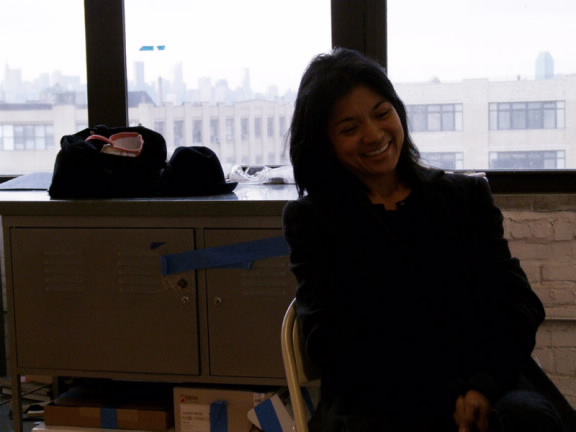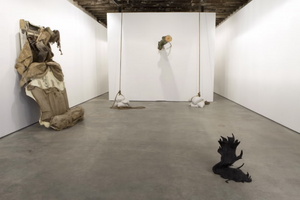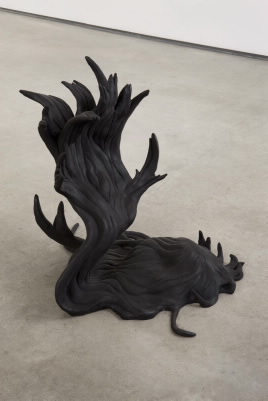This is an archive of the ArtCat Zine, 2007-2009. Please visit our new project, IDIOM.
Michelle Lopez with Andrew Robinson
Michelle Lopez - The Violent Bear It Away
21 March - 17 May 2009 at Simon Preston Gallery
301 Broome Street
A conversation with artists Michelle Lopez and Andrew Cornell Robinson that took place in both of the artists’ studios in Bushwick, Brooklyn on 7 April 2009.
Andrew Cornell Robinson: When you went to California there was a shift in your work. In fact there seems to be several moments when your work has undergone significant shifts in attention and focus evidenced by the materials you use and your conceptual concerns.
Early on you started to work with leather, which became your signature material. Much of your work has had this intense exploration of material. What’s that about?
Michelle Lopez: Back in grad school, I was working with chocolate, and apple skins. I was trying to find a way to re-contextualize a material, something that was incredibly familiar to us. In a way the work is about how to invert something that is masculine and make it feminine, create this ambiguity. The thing that I am interested in most, is exploring androgyny. In terms of my education, I was interested in a feminist perspective, but I wasn’t really interested in a feminist aesthetic.
AR: What do you mean, like Judy Chicago?
ML: I was interested in feminist theory but not entirely convinced by the art, well yeah Judy Chicago, like all of the artists associated with early feminism.
ACR: A friend of mine calls that aesthetic “My Tortured Vagina” art.
ML: (Laughter) Exactly! So in a way I wanted to create work that was specifically non-gendered. For me it’s really hard to talk… I don’t want to be specific about the language. I feel like I can so easily get pinned down, and I don’t want to, so it’s better for me to keep the ideas open.
ACR: I understand totally. So you mentioned androgyny. And when I looked at you’re installation of “Southern Trees / Black September”, the Sycamore tree sticking through the wall so violently; the thing that struck me the most was the meticulous details, the moments where you wrap and repair broken twigs. There is something in your work that plays with this transgression of material and repair, disguise and revelation. It’s awkward, melancholy and sublime.
ML: Jeffrey Uslip uses the word “rehabilitation” in the catalogue essay he wrote in conjunction with my current exhibition. In a way it’s trying to rehabilitate something that doesn’t exist. Like look at the smashed leather car piece, "Woadsonner (edit)", it's a redux of a failed piece, and in crushing and crashing it, the work gets rehabilitated through that trauma. Or take the Sycamore, I was trying to make the tree do something it’s not supposed to do. I mean that branch represents for me… (trails off) … and, I’ve never taken a stance on it, but its very much about this sense of not being seen.
ACR: In what sense? As a woman? Or as a woman of color?
ML: Yeah! As a woman of color. Really taking a stance. And that’s in relation to this wig piece, “Special Mission Project / Akira revisited”. It’s a response to that whole Takashi Murakami "Superflat" culture, in that it’s kind of understood that there’s this objectified Asian woman. And this wig works as a counterpoint, a rejection to the micro-aggressions, the false promise of Murakami's neo-pop position.
This show is really scary for me because it’s the first time that I take a position on any of these things. I feel the way that I’ve been thinking about materiality a lot in my work, including in the “Adventures of the Skin Trade” exhibition that I did at Deitch Projects back in September 2001 was this whole notion of how this skin [leather] can create a mask, and protect objects, and protect identity... I mean the show [at Deitch Priojects] was an excuse to display those objects in a non-pedestal situation.
ACR: with the sand?
ML: Yeah, even though they probably required pedestals. What was interesting for me was the fact that, that exhibition opened during 9-11 and the sand felt like war trenches. The leather sculptures, including the leather covered sports car “Woadsonner”, that was in an installation with the Public Art Fund, were these conceptual appropriation of objects layered into each other to make a kind of pop abstraction. The work was in some way a moment of crisis for me. I was responding to the leather covered car “Boy”—the easiness of it—the cleverness of the cultural appropriation by examining what it would mean for me to investigate formalism. And 9-1 made that work irrelevant.
ACR: I get it.
ML: … and I really had to question what I was really all about. I left the art world, and moved to the west coast to teach and work at Berkeley. It was this moment of assessing what it really meant to be making art. 9-11 was a pivotal moment because not only was it socially and culturally omni-present but it impacted me on a deep personal level. It tore me down and so all the work after that was tearing things apart, failure, crashing, breaking down.
ACR: So what happened at Berkeley? I mean your work shifted.
ML: Yeah, my work totally shifted. I just abandoned working in leather.
ACR: was that hard?
ML: It was so easy. Berkeley was great because it was this moment that I got to play with all these materials, and play with these other industries besides the leather industry. So I worked with Porsche, I worked in the car industry, I worked with toy people, and with Prosthetists... I was hired on this digital media initiative at Berkeley. And I got entrenched in this digital world. I was doing 3-D scanning, making wire frame objects on computers and printing them out as 3-D prototypes.
ACR: What's been interesting to me about the work that I’ve seen of yours over the years is that you manage to consistently bridge the gap between your conceptual research and your studio work. It seems to me that you make that transition from concept to then working intuitively with the materials. Is that accurate? Do you feel that you work intuitively?
ML: Yes, I feel that was the great gift of being in Berkeley, and just leaving New York, and not having the voices of others, the voices of the art world in my head. It was a real moment when I began to think differently about my process. And so there are a lot of things that happened, that I can’t entirely give away, … that’s why I feel very strongly about making the work, and learning how to do all these different techniques. In those moments something happens that I like to be a part of, so that if it doesn’t quite work for the piece, that I’m there to say “alright, wait, no, yes…”
ACR: I think it helps you keep it fresh. In the end it’s still just about working in the studio.
It reminds me of this really random story. My back ground is in ceramics, and I heard this story from a teacher, a potter. He did this test one year, he had two pottery 101 classes. The first class he said “You will get an A in this class based on your ability make a perfect pot.” And to the second class he said “You will be judged on the sheer quantity of pots that you make this year.”... He wanted to see what would happen. The first class got hung up on trying to make the one perfect pot, and the results were ugly and they all looked like shit, according to him. While the other class that made loads of pots, they made some of the most beautiful pots he had ever seen come from students. The lesson was to stop fixating on an ideal that doesn’t exist, and just make it. I bring that up, because I’ve often seen artists struggle, with the idea over the execution of the work. For example think back to the early 1990’s when we were in school the discourse at the time was dominated by identity politics A lot of it had rich narratives, and interesting histories, but when it came to execution a lot of it..
ML: .. fell apart.
ACR: Yeah. And I don’t see that happening in your work. I mean you are working through these ideas of identify and invisibility, but you work through the materials as well as the idea. And it becomes poetic, rather than only polemic.
ML: Well, it is interesting that you bring up grad school again. I’m sure that I was reacting against identity politics, at least the way it was being translated at the time. That’s why there is this part of me that is so concerned... what does it mean to identify myself in the work, and have it be about this minority experience, or to really say, or to really stake a claim to that. But to get back to that whole thing of perfection, it was this great moment, that happened in the process to let go of that idea. A lot of the times I feel that I am only a servant to the work, I have to ask the piece what it wants. And maybe that dilutes that, but I’m hoping that its…
ACR: In what way..
ML: You know I had my students read the Sol LeWitt sentences on conceptual art… . Stay on the concept, and don’t veer from it and if you veer from it its going to compromise the project.
ACR: What did they think?
ML: They thought it was a little dated, and a little too rigid. And then I had them read the opposite, this Phillip Guston lecture, which is totally opposite. But both of them are about how to have courage in the work, how to get out of the way. And both of them do it in radically different ways. Of just acknowledging when something is interesting, maybe a little less linear. You know I think with this piece, having a child, not to get cliché,
ACR: Wha?
ML: (Laughter) …With the installation of the tree, we had two weeks. We got a tree that the NYC parks department was cutting down. We installed the tree, and cut the branches and we had to do all this configuration, cast a branch from the tree, and once we got the cast back into the gallery, all of a sudden everything changed. It was really this performance moment, like what is this piece really doing, and what does it mean? And when we brought the cast branch in, the tree was very majestic, even more majestic then it is now, just blooming, so baroque. So there was a moment the night before the opening that I said to my assistant Crisman, that we had to just destroy this piece, that if it’s really going to be about the “Violent Bearing it Away” if we are really going to make it mean something, we had to do something more important than just bringing a tree into the gallery , so we just started chain-sawing everything off that was majestic about it.
ACR: It's like an anti-Judy Pfaff.
ML: (Laughter) yeah to find a broken, sad quality to it so it would droop a lot more. And it was just this moment that I was feeling like: screw it. I had to say screw it in order for anything meaningful to happen. And so I think in a lot of ways, I had to be down on my hands and knees and be like get out of the way. I have to really get out of the way, because if I try to hold on to this tree, then potential meaning is not going to happen. When I was doing research for this show about terrorist hijacking and plane crashes, because of the way 9-11 had influenced me, I found out that a similar 9-11 incident had happened exactly on my date of birth. The Dawson Field Hijacking, which coined the Black September movement, made me contend with how I imagine being somehow aligned with this tragedy and so I have to confront it, mainly for my own survival.
ACR:It's interesting to hear you talk this way, because my first impression when I walked into your show was that you had come in, rammed that tree through the wall and walked out!
ML: (Laughter)
ACR: It’s very intense. And I loved hearing that moment, when you recognize that it's too majestic and you need to take it apart. That so resonates with me. I love that awkwardness, those uncomfortable visual juxtapositions…I feel that we’ve been in a period within our culture where everything has been black and white, schizoid and we’re not in that place any more. I think this move into the unknown, the uncomfortable, will continue to be important. In a way it harkens back to the innovations that took place in the 1970’s New York art world; in that artists were breaking boundaries, trying new materials, no one was really making any money, but artists were moving things forward. It was exciting, and I think it is again.
ML: I’ve been feeling very optimistic about this time we are in. I have nothing to lose. And so it’s a great opportunity for, well really that is what the “Violent Bear It Away” is: it’s about letting the house burn down and having there be fertile ground, so that this whole notion of the Flannery O'Connor book that the exhibition derives its title, is about destroying a legacy. A legacy of dogma, and belief systems, and this whole notion of burning in order to “clean.”. The premise of the book is the baptismal of a child, and the future of a child and what it means to have this sacred entryway for this child turn in on itself tragically. Kind of how I see it in terms of an artistic process—how one can sabotage the child for the sake of an idea. In this book, there is a very climactic ending in that the child is drowned while being baptized.
ACR: That’s devastating…
ZINE
HOME
TIPS / COMMENTS
CATEGORIES
CONTRIBUTORS
- Greg Afinogenov
- B. Blagojevic
- Adda Birnir
- Susannah Edelbaum
- Julie Fishkin
- Paddy Johnson
- Jessica Loudis
- Christopher Reiger
- Andrew Robinson
- Peter J. Russo
- Blythe Sheldon
- S.C.Squibb
- Hrag Vartanian



